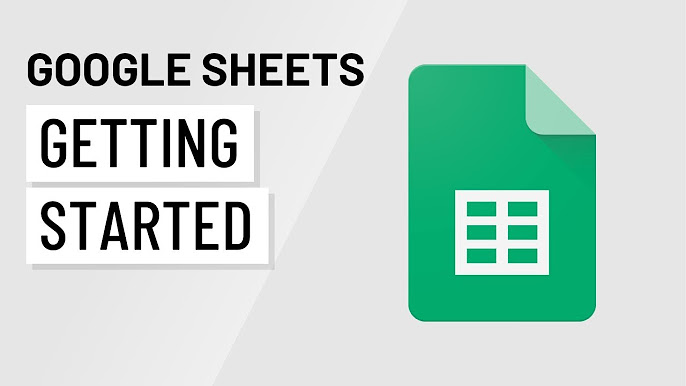
Introduction
In the realm of digital productivity, Google Sheets stands tall as a versatile and powerful tool for creating, analyzing, and visualizing data in spreadsheet format. Whether you are a professional managing financial data, a student working on assignments, or an enthusiast exploring the capabilities of spreadsheet software, this comprehensive guide will take you on a journey to get started with Google Sheets. From the basics of navigating the interface to advanced features that enhance data manipulation and analysis, this guide will empower you to harness the full potential of Google Sheets.
Section 1: Introduction to Google Sheets
1.1 What is Google Sheets?
Google Sheets is a cloud-based spreadsheet application that allows users to create, edit, and collaborate on spreadsheets online. It is part of the Google Workspace suite of productivity tools and provides a wide range of features for data organization, analysis, and visualization.
1.2 Why Use Google Sheets?
- Collaboration: Google Sheets allows multiple users to work on the same spreadsheet simultaneously, fostering real-time collaboration.
- Cloud-Based Storage: Spreadsheets are stored in the cloud, providing accessibility from any device with an internet connection.
- Automatic Saving: Changes are saved automatically, reducing the risk of data loss.
Section 2: Accessing Google Sheets
2.1 Creating a Google Account
To access Google Sheets, you need a Google account. If you don’t have one, sign up for a Google account at Google Account Sign-Up.
2.2 Navigating to Google Sheets
Once you have a Google account:
- Go to Google Sheets or access it through the Google Apps menu.
2.3 Creating a New Spreadsheet
- Click on the “+ New” button.
- Select “Google Sheets” from the dropdown menu.
2.4 Understanding the Google Sheets Interface
- Menu Bar: Houses various menus for formatting, data manipulation, and more.
- Toolbar: Provides quick access to commonly used tools.
- Spreadsheet Grid: Comprises rows and columns where data is entered and manipulated.
- Sheets: Multiple sheets can be added to a spreadsheet, each residing on its own tab at the bottom.
Section 3: Basic Spreadsheet Operations
3.1 Entering Data
- Click on a cell.
- Enter data.
- Press “Enter” to move to the next cell.
3.2 Formatting Cells
- Select the cells you want to format.
- Use the toolbar to apply formatting options such as font style, size, and color.
3.3 Managing Rows and Columns
- Right-click on a row or column header.
- Choose options like insert, delete, or hide.
3.4 Basic Formulas
- Click on a cell.
- Type “=” to start a formula.
- Enter the formula (e.g., =SUM(A1:B2)).
- Press “Enter.”
Section 4: Advanced Features in Google Sheets
4.1 Functions and Formulas
Explore a variety of functions and formulas to perform complex calculations:
- SUM: Adds up a range of numbers.
- AVERAGE: Calculates the average of a range.
- VLOOKUP: Searches for a value in a table and returns a corresponding value.
4.2 Data Validation
Ensure data accuracy by setting up data validation rules:
- Select the cells to validate.
- Go to “Data” > “Data validation.”
- Set criteria for valid data.
4.3 Conditional Formatting
Highlight data based on specified conditions:
- Select the cells.
- Go to “Format” > “Conditional formatting.”
- Set rules for formatting.
4.4 Pivot Tables
Summarize and analyze data using pivot tables:
- Select the data range.
- Go to “Data” > “Pivot table.”
- Configure rows, columns, and values.
4.5 Charts and Graphs
Visualize data with a variety of chart options:
- Select the data.
- Go to “Insert” > “Chart.”
- Choose the chart type and customize options.
Section 5: Collaborating on Google Sheets
5.1 Sharing and Permissions
Collaborate with others by sharing your spreadsheet:
- Click on the “Share” button in the top-right corner.
- Enter email addresses or shareable link.
- Set permission levels (Viewer, Commenter, or Editor).
5.2 Commenting and Discussions
Facilitate discussions with comments:
- Highlight the cell.
- Right-click and choose “Comment.”
- Collaborators can leave comments and replies.
5.3 Real-Time Editing
Collaborate in real-time with multiple users:
- Share the spreadsheet.
- Collaborators can edit simultaneously.
5.4 Version History
Review and revert to previous versions of the spreadsheet:
- Go to “File” > “Version history” > “See version history.”
- View and restore previous versions.
Section 6: Working with Google Sheets Offline
6.1 Enabling Offline Mode
- Click on the gear icon in the top-right corner.
- Select “Settings.”
- Enable “Offline.”
6.2 Accessing Offline Files
- Open Google Chrome.
- Type “chrome://drive” in the address bar.
- Access and edit offline files.
Section 7: Additional Tips and Tricks
7.1 Keyboard Shortcuts
Efficiently navigate and perform actions with keyboard shortcuts:
- Ctrl + C / Cmd + C: Copy.
- Ctrl + V / Cmd + V: Paste.
- Ctrl + Z / Cmd + Z: Undo.
7.2 Add-Ons and Extensions
Explore Google Sheets add-ons and extensions for additional functionality:
- Go to “Add-ons” in the menu.
- Select “Get add-ons.”
7.3 Google Sheets Mobile App
Extend your productivity to mobile devices:
- Download the Google Sheets app.
- Access and edit spreadsheets on the go.
Conclusion
Embarking on the journey of getting started with Google Sheets opens up a world of possibilities for organizing, analyzing, and visualizing data. Whether you’re a beginner navigating the basics or an experienced user exploring advanced features, this comprehensive guide has provided you with the tools and knowledge to navigate the expansive landscape of Google Sheets. As you integrate spreadsheet prowess into your digital toolkit, the collaborative, cloud-based nature of Google Sheets will undoubtedly elevate your productivity and efficiency in managing data. Welcome to the world of dynamic spreadsheets, where data transforms into actionable insights, and collaboration thrives in the cloud.